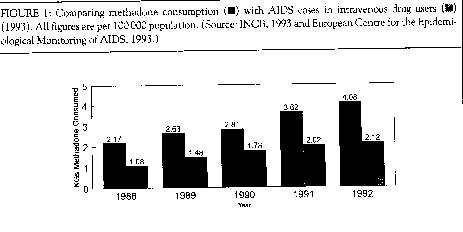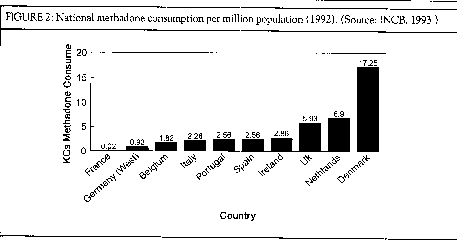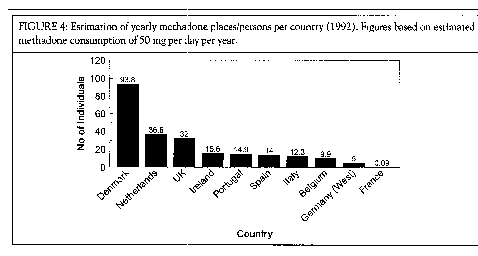| Articles - Opiates, heroin & methadone |
Drug Abuse
METHADONE PROVISION IN THE EUROPEAN UNION
Michael Farrell, Jan Neeleman, Michael Gossop, Paul Griffiths, Ernst Buning* Emily Finch and John Strang, The National Addiction Centre, London, UK
This article describes the present level of methadone substitution in Europe and the changes that have occurred up to 1993. There has been a considerable expansion in the level of provision. It summarises briefly the variations in the organisation of opiate substitution treatment in Europe.
The actual mode of delivery of methadone substitution and even the definition of what constitutes the core elements varies widely (Gossop and Grant 1990). There is no simple distinction between methadone maintenance and other forms of methadone intervention, sometimes referred to as maintenance to abstinence. Maintenance may be defined by the duration and the goals of such intervention. However, there is no consensus definition of duration or goals within or between countries, and what is termed 'maintenance' in the Netherlands is likely to be termed 'gradual detoxification' in the UK. Studies of the organisation and delivery of programmes report major variation in the effectiveness of delivery (General Accounting Office, 1990; Ball and Ross, 1991).Ball and Ross's work has highlighted the fact that the benefits of methadone maintenance depend on the quality and organisation of service delivery. Historically, the organisation and nature of drug services in each country are predominantly defined by the cultural background and legislative framework of each country. In addition to these two factors, the health and social welfare and the criminal justice system have strongly shaped the pattern of response. The multiplicity of factors ensures that each country has striking and unique characteristics to the organisation of its drug services. The attitude to, and the organisation of, substitution services and, in particular, methadone services reflects this national variation.
For the purposes of the full study (Farrell et al., 1996) each country had at least one key national informant to provide an overview. Between two and five clinics were described with one programme in a major or capital city, a second programme in a second smaller city and, where possible, a more rurally based programme. These programmes were chosen in consultation with key national informants. They are not representative of all national services. The description of these clinics gives a picture of detailed practice and provides a qualitative description of national policy in action at the grass roots level.
A key informant approach was used to gain an overview at national level. Key informants were selected who had extensive experience of nationals services, and who were aware of research as well as clinical perspectives. In some countries with major regional variations, a number of regional informants were used to build up a national picture. Key informants varied from national providers or researchers to health officials. Each individual was interviewed using a semi structured questionnaire. In addition, available national information was requested, and data from all key national reports have been incorporated into the overview and individual country descriptions of the final report (Farrell et al., 1996).
QUALITY OF DATA
Efforts to describe the development and present extent of the drug problem and the organised response to that problem are hampered by a lack of good quality epidemiological data at a national level. There is also a considerable lack of well-organised information on services at a national level in many countries. The scarcity of reliable information creates problems for national service development and for policy planning. It also creates problems in compiling a cross-national report of this sort. Descriptions as such rely on best estimates and extrapolation from available data and there is a need for considerable caution in interpretation of much of the data because the lack of standardised modes of gathering information and the variable definitions used make cross-national comparisons difficult.
Estimates for opiate prevalence range from 150 to under 300 per 100 000 population and the overall impression is that, in spite of some variation, each country now has a sizable and comparable long-term opiate addict population.
Concern about HIV spread and awareness of the need to develop effective prevention measures have strongly shaped the development of drug policy and drug services. There is striking variation in the prevalence of drug-related HIV and AIDS both within and between countries. The contrast between southern European countries and northern European countries is striking with Italy, France and Spain experiencing a significantly higher problem.
However, this variation in viral transmission does not appear to be reflected in the levels of hepatitis C; Longer-term injectors in all countries appear to have rates between 60% and 80%.
USES OF METHADONE
Gossop and Grant in their WHO report (1990) on the content and structure of methadone programmes outline the two major uses for methadone in most countries. One is for detoxification and the second is for maintenance purposes. Gaining a clear picture of the ways in which methadone is used in programmes in different countries is difficult. Some countries appear primarily to use methadone for the purposes of maintenance to abstinence or in brief detoxification. The time scale for detoxification varies considerably with countries such as the UK describing treatment regimens lasting anything from 6 weeks to 48 weeks as a detoxification process whereas many countries would describe such a practice as maintenance prescribing.
Most European Union countries now appear to have substantial numbers of opiate addicts on methadone maintenance prescribing and appear to place far greater emphasis on long term maintenance. In some countries such as Spain l here seems to be considerable regional variation on this with some regions providing short term detoxification.

There has been a dramatic growth in methadone provision and, in particular, in methadone maintenance services in Europe between 1988 and 1992. Data from reports to the International Narcotics Control Board ( 1993 ) show a two to fivefold increase in the total amount of methadone consumed in the European Union countries. The countries with the largest net increase, such as Spain, France and Germany, and Ireland, started with a very low baseline; most of the countries confronted with the highest rates of HIV infection have responded with the expansion of methadone programmes. Italy's response has been more modest with an increase to 2 kg per million population. The UK has increased threefold from 2 kg to 6 kg. Countries such as Denmark and the Netherlands have remained steady at the highest levels of consumption. Overall, in Europe methadone consumption has doubled and parallels the growth in AIDS cases that are related to injecting drug use ( Figure 1 ) . The change in Switzerland, the USA and Australia has been similar. The range of per capita methadone consumption is 0.02 kg/million population in France to 17.5 kg/million population in Denmark ( Figure 2 ).

There is considerable difficulty in establishing the exact size of the methadone service population in many countries in the absence of a centralised data gathering system. However, for several countries reasonable estimates are available though some of these are confounded by through puts and short-term detoxification. They are based on estimates for longer-term methadone places. The figures range from 40 to 80 places per 100 000 population, with provision in France and Germany at less than 10 places per 100 000population (Figure 3). Since then, German provision has expanded to over 15 000 and Greece is also due to institute a methadone programme.

METHADONE PLACES
Considerable reservations have to be attached to t he efforts to assess the number of people on long term methadone maintenance. Using the national methadone consumption data from the INCB ( 1993 ) and assuming an average dose of 50 mg a day for a year, an estimate is made of total number of places in person-year terms for 1992 ( Figure 4 ). This estimate is of course based on the reliability of the reporting of consumption data which are undoubtedly subject to the same sort of problems as most of other data in this field. However, most of the data are consistent with national estimates for the number of places and demonstrates that Denmark has the highest per capita provision of methadone and GP prescribing per year. These data would appear to indicate that more short-term methadone contacts occur in the Netherlands than is immediately apparent. The lower rates in the Netherlands, Spain, Italy, Belgium and Ireland would suggest that a considerable amount of short term methadone is provided in these countries.

Using simple consumption or estimates of provision gives little information on the quality or effectiveness of drug substitution programmes both with in and between countries. The potential range of variations is striking, ranging from the formulation of the drug used to the mode of administration and programme organisation to the associated psychosocial intervention. The type of drug used is predominantly methadone, with some use of dihydrocodeine and buprenorphine. There are a limited number of places where diamorphine and other injectable drugs are used.
In the UK, where much attention is given to heroin prescribing, in reality it constitutes a very minor part of drug substitution. The organisation and administration vary with most countries providing supervised methadone consumption but most methadone in the UK is unsupervised. The involvement of primary care varies with no primary care involvement in France, Germany or Italy. There has been a dramatic growth in methadone provision in France, with almost 1000 places available in 1995.
CONCLUSION
The provision of methadone substitution reaches less than 20% of the opiate addict population in many countries. Methadone maintenance is one of the most rigorously evaluated interventions in the field of drug addiction. The failure of many European countries to organise the delivery of comprehensive, well organised programmes of demonstrated effectiveness is a failure to maximise on public health gain. The growth of programmes needs to be fashioned to ensure that they are the most effective for the largest number of people. In the absence of such provision the discussion and the debate on other forms of substitute prescribing are premature and obstruct the task of implementing effective conventional programmes.
Michaell Farrell, National Addiction Centre, Institute of Psychiatry, 4 Windsor Walk, London SE5 4SF, UK.
APPENDIX: KEY DATA SOURCES
European Centre for the Epidemiological Monitoring of AIDS (1993). AIDS Surveillance in Europe. Paris: World Health Organization.
Frischer M (1994). Substance Abuse Mortality: A Worldwide s Review. Prepared for UNDCP, Vienna.
International Narcotics Control Board ( 1993 ) . Narcotic Drugs Estimated World Requirements for 1994. Statistics for 1992. Vienna.
Pompidou Group ( 1993). The Multi-City Study. Council of Europe.
World Health Organization ( l99Z). European Summary o Drug Abuse . First Report ( 1985-1990) . Regional Office for Europe.
REFERENCES
Ball J, Ross A ( 1991 ). The Effectiveness ofMethadone Maintenance Treatment: Patients Programmes Services and Outcomes New York: Springer Verlag.
Farrell M, Neeleman J, Gossop M, Griffiths P, Buning E, Fin E, Strang J ( 1996) . A Review of the Legislation, Regulation a Delivery of Methadone in 12 Member States in the European Union, in press. Brussels: The European Commission.
General Accounting Office ( 1990). Methadone Maintenance Some Treatment Programs are not Effective: Greater Federal Oversight Needed. Washington DC: US Government Printing Office.
Gossop M, Grant M ( 1990). The Content and Structure of Methadone Treatment Programmes: A Study in Six Countries. World Health Organization, Programme on Substance Abuse.
The authors take sole responsibility for the use made of the information in this paper. This article is based on work funded by DG 5 in the European Commission.
*Ernst Buning is based at the International Bureau of the GG&GD in Amsterdam.












